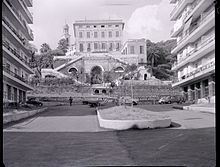Ligurian Archeology Museum
Coordinates: 44 ° 25 ′ 45.8 ″ N , 8 ° 49 ′ 2.6 ″ E

The Ligurian Archeology Museum ( Museo di archeologia ligure ) is located in the buildings of the Villa Durazzo-Pallavicini in the Pegli district of the Italian city of Genoa .
The museum offers a wide panorama of the ancient history of the Liguria region . For example, specimens of 80,000 year old cave bears are exhibited , which made their home in the numerous Ligurian caves and grottoes during the last ice age . A second focus of the Museum of Archeology are the Roman branches in the region; one of the most important came to light during work on the Genoese underground in the 1990s.
The exhibition was greatly expanded around 2000 and equipped with didactic material. The most important exhibits include:
- Graves from the Paleolithic , which are among the best preserved in Europe; the oldest is dated to 20,000 years past funeral and, because of its exceptionally rich furnishings, the grave of the Principe delle Arene Candide called
- Graves of the first inhabitants of Genoa, which date back to 500 BC. Go back; they were built along the trade routes between Etruria and Marseille , which was then Greek ; Greek ceramics, Etruscan bronzes, alabaster vases and glasses from the Middle East are exhibited in the museum
- the first stele in the Lunigiana region , which bears witness to war heroes from the Copper Age
- the bronze tablet of Polcevera , which represents the first legal act in Liguria
The exhibition is rounded off by a valuable collection from Prince Oddone Eugenio Maria di Savoia , son of Victor Emmanuel II . It includes Greek vases, bronzes, ceramics, glasswork and Roman gems .
Web links
- Official homepage (Italian, English)
